

Adept. An adept is an individual identified as having attained a specific level of knowledge, skill, or aptitude in doctrines relevant to a particular author or organization.

Etymology[edit] The word "adept" is derived from Latin adeptus 'one who has attained' (the secret of transmuting metals).[1] Authors[edit] H. P. Although Madame Blavatsky makes liberal use of the term adept in her works[2] to refer to their minor function as caretaker of ancient occult knowledge. Alice Bailey[edit] In Alice Bailey's body of writing she outlines a hierarchy of spiritual evolution and an initiatory path along which an individual may choose to advance. Wicca. This pentacle, worn as a pendant, depicts a pentagram, or five-pointed star, used as a symbol of Wicca by many adherents.
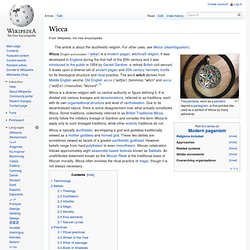
Wicca is a diverse religion with no central authority or figure defining it. It is divided into various lineages and denominations, referred to as traditions, each with its own organisational structure and level of centralisation. Due to its decentralized nature, there is some disagreement over what actually constitutes Wicca. Some traditions, collectively referred to as British Traditional Wicca, strictly follow the initiatory lineage of Gardner and consider the term Wicca to apply only to such lineaged traditions, while other eclectic traditions do not. Hermeticism. Not to be confused with Hermit.

Hermeticism, also called Hermetism,[1][2] is a religious and philosophical/esoteric tradition based primarily upon writings attributed to Hermes Trismegistus ("Thrice Great").[3] These writings have greatly influenced the Western esoteric tradition and were considered to be of great importance during both the Renaissance[4] and the Reformation.[5] The tradition claims descent from a prisca theologia, a doctrine that affirms the existence of a single, true theology that is present in all religions and that was given by God to man in antiquity.[6][7] Many Christian writers, including Lactantius, Augustine,[8] Thomas Aquinas[citation needed], Marsilio Ficino, Giovanni Pico della Mirandola, Giordano Bruno, Campanella, Sir Thomas Browne, and Emerson, considered Hermes Trismegistus to be a wise pagan prophet who foresaw the coming of Christianity.[9][10] History[edit] Late Antiquity[edit]
Ritual. A priest elevates the Host during a Catholic Mass, one of the mostly widely performed rituals in the world.
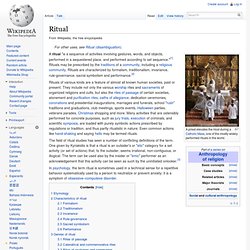
A ritual "is a sequence of activities involving gestures, words, and objects, performed in a sequestered place, and performed according to set sequence.
Western esotericism. Western esotericism (also Western hermetic tradition, Western mysticism, Western inner tradition, Western occult tradition, and Western mystery tradition) is a broad spectrum of spiritual traditions found in Western society, or refers to the collection of the mystical, esoteric knowledge of the Western world.

This often includes, but is not limited to, philosophy, meditation, herbalism, alchemy, astrology, divination, and various forms of ritual magic. The tradition has no one source or unifying text, nor does it hold any specific dogma, instead placing emphasis on spiritual "knowledge" or gnosis and the rejection of blind faith. Although the protosciences were widespread in the ancient world, the rise of modern science was born from occult varieties of Western Esotericism reinterpreted in the "Age of Enlightenment" and is documented within the field known as the History of science. Definition[edit] As a category, Western esotericism has been defined in various ways. Left-hand path and right-hand path. The Baphomet, from Eliphas Levi's "Dogme et Rituel de la Haute Magie", 1854, adopted symbol of some "Left-Hand Path" belief systems.
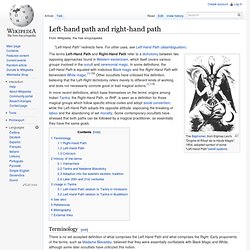
The terms Left-Hand Path and Right-Hand Path refer to a dichotomy between two opposing approaches found in Western esotericism, which itself covers various groups involved in the occult and ceremonial magic. In some definitions, the Left-Hand Path is equated with malicious Black magic and the Right-Hand Path with benevolent White magic.[1]:152 Other occultists have criticised this definition, believing that the Left-Right dichotomy refers merely to different kinds of working, and does not necessarily connote good or bad magical actions.[1]:176 Terminology[edit] There is no set accepted definition of what comprises the Left-Hand Path and what comprises the Right.
Early proponents of the terms, such as Madame Blavatsky, believed that they were essentially conflatable with Black Magic and White, although some later occultists have criticized this notion.
Esotericism. Μορφήγένεσις. Indigo children. Indigo children, according to a pseudoscientific New Age concept, are children who are believed to possess special, unusual and sometimes supernatural traits or abilities.[4] The idea is based on concepts developed in the 1970s by Nancy Ann Tappe[5] and further developed by Jan Tober and Lee Carroll.

Invocation. An invocation (from the Latin verb invocare "to call on, invoke, to give") may take the form of: These forms are described below, but are not mutually exclusive.
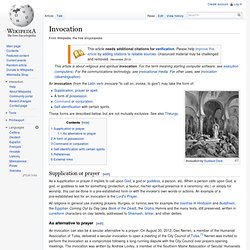
See also Theurgy. Magnum opus (alchemy) Colors of the magnum opus seen on the breastplate of a figure from Splendor Solis The Great Work (Latin: Magnum opus) is an alchemical term for the process of creating the philosopher's stone.
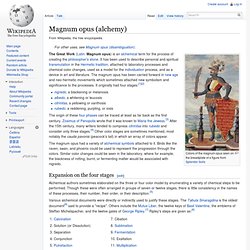
It has been used to describe personal and spiritual transmutation in the Hermetic tradition, attached to laboratory processes and chemical color changes, used as a model for the individuation process, and as a device in art and literature. The magnum opus has been carried forward in new age and neo-hermetic movements which sometimes attached new symbolism and significance to the processes. It originally had four stages:[1][2] The origin of these four phases can be traced at least as far back as the first century.
The magnum opus had a variety of alchemical symbols attached to it. Alchemical authors sometimes elaborated on the three or four color model by enumerating a variety of chemical steps to be performed. Sacred mysteries. Wrisberg epitaph in Hildesheim Cathedral, showing distribution of the divine graces by means of the church and the sacraments, or mysteries.
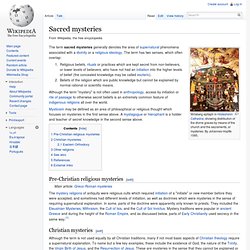
By Johannes Hopffe 1585. The term sacred mysteries generally denotes the area of supernatural phenomena associated with a divinity or a religious ideology. The term has two senses, which often overlap: Religious beliefs, rituals or practices which are kept secret from non-believers, or lower levels of believers, who have not had an initiation into the higher levels of belief (the concealed knowledge may be called esoteric).Beliefs of the religion which are public knowledge but cannot be explained by normal rational or scientific means.
Although the term "mystery" is not often used in anthropology, access by initiation or rite of passage to otherwise secret beliefs is an extremely common feature of indigenous religions all over the world. Pre-Christian religious mysteries[edit] Sacred geometry. As worldview and cosmology[edit] The belief that God created the universe according to a geometric plan has ancient origins. Plutarch attributed the belief to Plato, writing that "Plato said God geometrizes continually" (Convivialium disputationum, liber 8,2). In modern times the mathematician Carl Friedrich Gauss adapted this quote, saying "God arithmetizes".[2] At least as late as Johannes Kepler (1571–1630), a belief in the geometric underpinnings of the cosmos persisted among scientists.
Closeup of inner section of the Kepler's Platonic solid model of planetary spacing in the Solar system from Mysterium Cosmographicum (1596) which ultimately proved to be inaccurate. Sacred bull. Stone Age[edit] Aurochs are depicted in many Paleolithic European cave paintings such as those found at Lascaux and Livernon in France. Their life force may have been thought to have magical qualities, for early carvings of the aurochs have also been found.
The impressive and dangerous aurochs survived into the Iron Age in Anatolia and the Near East and was worshipped throughout that area as a sacred animal; the earliest survivals of a bull cult are at neolithic Çatalhöyük.
Μάγος. Enochian chess. Μετεμψύχωσις. Ἕνωσις. Spiritual evolution. Emanationism. Νοταρικόν. קַבָּלָה. Στοιχεῖον. Ἱερός. Ancient Greek[edit] Alternative forms[edit] ἱαρός (hiaros) (Doric)ἱρός (hiros) (Ionic)ἷρος (hiros) (Aeolic) Κοσμολογία. Μαντεία. Ἀστρολογία. Table of correspondences. History[edit] Tables of correspondences are not limited to magical spellcasting. Gnostic books in the Nag Hammadi Library contain lists of aeons and archons (good and evil beings), correlating them to virtues and vices.
Αλχημεία. Merkabah. Etymology[edit] The noun merkabah "thing to ride in, cart" is derived from the consonantal root r-k-b with the general meaning "to ride". Seal of Solomon.